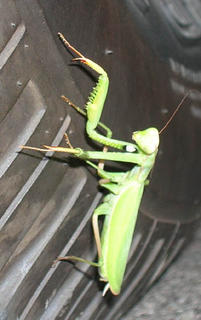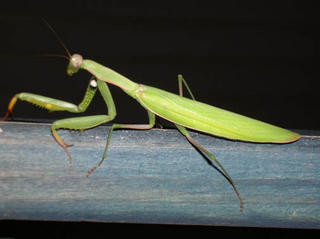 Most living things have a strong survival instinct, but not Praying Mantises, particularly not this one, which seemed to think that the rearward underside of an SUV tire was an ideal location to set up shop. When this particular species, the European Mantis, was introduced from Europe in 1899, the terror that should have accompanied the arrival of an exotic voracious carnivorous insect was tempered by the fact that Gypsy Moths were at that time making a point of what a bad idea it is to introduce an exotic voracious herbivorous insect in the hope of jump-starting a domestic silk industry. The European Mantis failed to address the Gypsy Moth problem, and failed to develop into a problem of its own, when it turned out that its preferred prey was other Praying Mantises.
Most living things have a strong survival instinct, but not Praying Mantises, particularly not this one, which seemed to think that the rearward underside of an SUV tire was an ideal location to set up shop. When this particular species, the European Mantis, was introduced from Europe in 1899, the terror that should have accompanied the arrival of an exotic voracious carnivorous insect was tempered by the fact that Gypsy Moths were at that time making a point of what a bad idea it is to introduce an exotic voracious herbivorous insect in the hope of jump-starting a domestic silk industry. The European Mantis failed to address the Gypsy Moth problem, and failed to develop into a problem of its own, when it turned out that its preferred prey was other Praying Mantises.
I like Praying Mantises, and ladybugs, and butterflies. From a distance these look like cute little insects, but up close they are as interesting and violent as any big game in darkest Africa. While Mantises are taking a break from eating each other they will tear into other insects, catching them in their claws and nibbling off their delicious, delicious heads while the poor dears cry "Please help me! Please help me!" in their adorable little helium-pitched voices. The young stages of ladybugs are known as "lions" for their predatory habits - God help you if you're an Aphid and there's a ladybug lion about. And butterflies look so pretty from a distance, but up close they're all freaky and nightmarish, with huge eyes and furry bodies and long, coiled sucking proboscises that pop out of their heads and taste receptors in their clawed feet. Plus their caterpillars provide an illustrative example of one of the cruelest and most horrible fates in the living world when a predatory wasp injects its eggs into the body of a caterpillar which is eventually eaten from within over a period of time by the growing young while it is kept mercilessly alive for as long as possible.
Not wanting to see such an interesting insect squished as soon as the driver of the SUV decided to leave the bar, I took the radical step of interfering with its self-determination by scooping it in my hands and placing it on a nearby railing for further study.
 It should be noted that this Mantis was only about 3.5 or 4 inches long. (The focus on my lens at this distance is so tight that the insect's abdomen and hindlegs are in focus while its thorax, head and forelegs are out of focus.) Also, the white spots outlined in black on its forelimbs (near where its "armpits" would be if it had them) are not physical damage or a fungal infection as I initally surmised, but are actually a normal part of the physiology of the European Mantis and are a primary indicator for distinguishing it from other species of Mantids.
It should be noted that this Mantis was only about 3.5 or 4 inches long. (The focus on my lens at this distance is so tight that the insect's abdomen and hindlegs are in focus while its thorax, head and forelegs are out of focus.) Also, the white spots outlined in black on its forelimbs (near where its "armpits" would be if it had them) are not physical damage or a fungal infection as I initally surmised, but are actually a normal part of the physiology of the European Mantis and are a primary indicator for distinguishing it from other species of Mantids.So what happened to the Mantis of Certain Doom? I have no idea. I left it on the railing and went back for the band's next set, and when I came out again it was gone. With any luck it was off eating Gypsy Moths. Odds are it just got eaten by another Mantis.

This comment has been removed by a blog administrator.
ReplyDeleteMy bet is the Mantis went back to trying to eat the SUV.
ReplyDeleteGoooood Mantis.
beautiful pictures harold, you have an eye. well you have alot of other things too, but definately an eye.
ReplyDelete